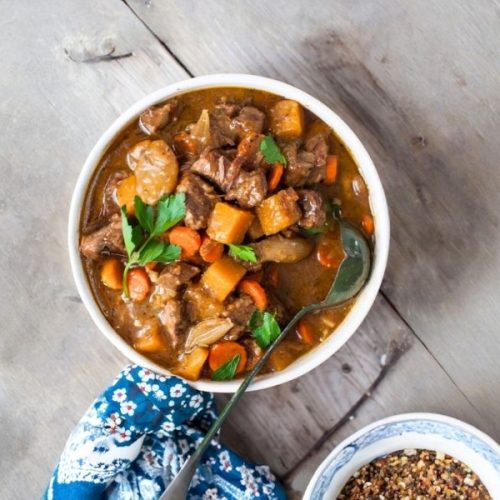
Classic Beef Stew with Root Vegetables
A slow-braised beef stew bursting with flavor from root vegetables, fresh herbs, and a rich homemade gravy. This classic dish balances tender meat with nutrient-rich vegetables and is perfect for cozy meals and easy leftovers.
Equipment
- 1 large Dutch oven (3.5 qt)
- 1 Tongs
- 1 Rubber spatula
- 1 Cutting Board
- Measuring Spoons Set
Ingredients
- 2 pounds beef stew meat cut into chunks
- 1/3 cup all-purpose flour
- 1 teaspoon fine sea salt plus more to taste
- Freshly ground black pepper to taste
- 3 tablespoons olive oil divided
- 3 teaspoons salted butter divided
- 3 cups beef broth divided
- 1/3 cup red wine or beer optional, for deglazing
- 6 French shallots peeled and halved
- 2 small onions peeled and quartered
- 1 teaspoon fresh thyme leaves or 1/2 teaspoon dried
- 1/2 teaspoon dried rosemary crushed
- 2 garlic cloves minced
- 1 pound rutabaga peeled and diced into 1-inch cubes
- 3 medium carrots peeled and sliced into rounds
- 1 teaspoon Dijon mustard
- 1 tablespoon Worcestershire sauce
Instructions
- Prepare the Oven and Ingredients: Preheat your oven to a low temperature of 275°F (135°C). Position the oven rack in the lower third to accommodate your cooking pot comfortably. Have all your vegetables peeled, chopped, and ready to go.
- Season and Coat the Beef: Pat the beef pieces dry using paper towels to remove excess moisture. In a shallow dish, combine the flour with 1 teaspoon of salt and a generous amount of freshly ground black pepper. Toss the beef chunks in the seasoned flour until each piece is evenly coated.
- Brown the First Batch of Beef: Heat 1 tablespoon olive oil and 1 teaspoon butter over medium heat in a heavy-bottomed Dutch oven or braiser with a tight-fitting lid. When the butter starts to foam and sizzle, add half of the coated beef in a single layer without crowding. Brown the meat on all sides, turning carefully with tongs until a rich crust forms. Transfer browned beef to a clean bowl.
- Deglaze and Add Flavor: Pour approximately 1/2 cup of beef broth into the hot pot. Using a rubber spatula, scrape the browned bits stuck to the bottom — these add deep flavor to the stew. Pour this flavorful liquid over the browned beef in the bowl.
- Brown Remaining Beef and Deglaze: Repeat the browning process with the remaining beef using the remaining 1 tablespoon olive oil and 1 teaspoon butter. After browning, deglaze the pot with the red wine or beer if using. Scrape the bottom again to lift all browned bits. Transfer the second batch of beef to the bowl with the first.
- Sauté Vegetables and Herbs: Add the shallots and onions to the pot and sauté in the remaining fat over medium heat for about 2 minutes until they start to soften. Sprinkle in the thyme, rosemary, and minced garlic, stirring to release their aromas. Then add the diced rutabaga and carrot slices. Cook everything together for 3 to 4 minutes until the edges of the vegetables begin to soften.
- Create the Stew Base: Sprinkle about 2 tablespoons of the seasoned flour over the vegetables. Stir well to coat and cook for an additional minute to remove the raw flour taste. Slowly pour in the remaining beef broth while stirring to combine and scrape any stuck-on bits from the pot’s bottom.
- Combine and Braise: Return the browned beef and all accumulated juices back into the pot. Stir in the Dijon mustard and Worcestershire sauce. Ensure the liquid just covers the meat and vegetables. Place the lid securely on the pot and transfer it to the preheated oven.
- Slow Cook for Tenderness: Allow the stew to cook undisturbed for 3 hours to tenderize the beef and meld the flavors beautifully.
- Final Cooking Stage: Remove the lid and continue cooking the stew uncovered for another hour to thicken the broth and concentrate the flavors.
- Rest and Season: Take the stew out of the oven and let it rest for about 15 minutes. The stew will thicken as it cools. Taste and adjust salt and pepper as needed before serving.
Notes
- Browning is Key: Don’t rush the browning process. Ensuring a good crust on the beef is essential for developing the stew’s rich flavor profile. Work in batches to avoid overcrowding the pan.
- Optional Alcohol: Using red wine, beer, or a strong cider for deglazing adds an extra layer of complexity, but plain beef broth works just fine if you prefer to omit alcohol.
- Butter Boost: For an indulgent touch, swirl in a tablespoon or two of butter after cooking to enrich the stew’s texture and flavor.
- Serving Suggestions: This stew pairs wonderfully with crusty bread or creamy mashed potatoes to soak up the savory sauce.
- Storage Tips: Leftovers taste even better the next day. Store in an airtight container in the refrigerator for up to 4 days or freeze for up to 3 months.